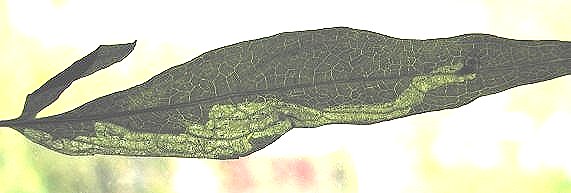|
||||||
|
Liriomyza
eupatoriana Spencer, 1954 Liriomyza
eupatoriana
Spencer, 1954c. Entomologist's mon. Mag. 90: 217 |
|||||||||||||||||||||||||||||||||||||||||||||||||||||
Leaf-miner: Mine filling apex of leaf segment, with short final section extending further into leaf. Pupation normally in leaf at end of mine. Corridor, almost invariably in the ultimate cm of the tip of a leaf segment. The corridor is contorted so strongly that a compact secondary blotch is formed. When exeptionally the mine is not in the leaf tip, it is closely adjoining the leaf margin; never is a mine formed in the leaf centre. Frass irregular, in black threads and lumps, frequently at wide intervals, on alternate sides of the mine. The mine is upper-surface, except for the very last section that is lower-surface. Here pupation takes place. The puparium projects for about half of its length out of the mine (Bladmineerders van Europa). A convoluted upper side gallery that may form a secondary blotch filling apex of leaf segment. Frass in closely spaced grains that may form streaks or strings (British leafminers).
Larva: The larvae of flies are leg-less maggots without a head capsule (see examples). They never have thoracic or abdominal legs. They do not have chewing mouthparts, although they do have a characteristic cephalo-pharyngeal skeleton (see examples), usually visible internally through the body wall. Posterior spiracles each with 3 bulbs (Bladmineerders van Europa). Puparium: The puparia of flies are formed within the hardened last larval skin or puparium and as a result sheaths enclosing head appendages, wings and legs are not visible externally (see examples). Hosts in Great Britain and Ireland:
Hosts elsewhere:
Time of year - mines: June-August. Time of year - adults: Currently unknown. Distribution in Great Britain and Ireland: Wiltshire (Heddington) and Cambridgeshire (Chippenham Fen) (Spencer, 1972b: 54). Distribution elsewhere: Widespread in continental Europe, including Germany (von Tschirnhaus, 1999), Czech Republic, French mainland, Hungary, Italian mainland, Lithuania, Poland, Spanish mainland and Yugoslavia (Fauna Europaea). NBN Atlas links to known host species:
British and Irish Parasitoids in Britain and elsewhere:
|
| Last updated 09-Jul-2019 Brian Pitkin | ||

